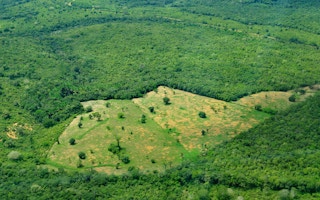Technology giant Google and the United Nations Food and Agriculture Organisation on Tuesday unveiled a new digital tool that will allow countries to track land use change and calculate emissions reductions from avoiding deforestation more accurately.
To continue reading, subscribe to Eco‑Business.
There's something for everyone. We offer a range of subscription plans.
- Access our stories and receive our Insights Weekly newsletter with the free EB Member plan.
- Unlock unlimited access to our content and archive with EB Circle.
- Publish your content with EB Premium.
Called Collect Earth and presented at the United Nations climate change conference (COP 22) in Marrakesh, Morocco, the tool is the result of a partnership between Google and FAO inked last year, and will provide access to large collections of free, high-resolution satellite imagery and cloud computing services.
The tool, which offers countries an accessible yet technically advanced way to track land use change, account for carbon, and develop forest and land use policies, is one of a dozen new initiatives to promote the protection and sustainable management of forests launched at COP 22 as part of the UN’s Forest Action Day, a part of the Global Climate Action Agenda.
This is an initiative by France—which hosted last year’s climate conference in Paris—and Morocco to promote deeper partnerships between governments, cities, businesses, investors, and citizens to tackle climate change.
Helen Clark, administrator of the United Nations Development Programme, said in a statement: “Forests are one of the largest and most cost-effective responses we have to climate change.” Forest loss and degradation currently account for about 12 per cent of global carbon emissions, more than the entire transport sector combined.
“Countries, civil society, the private sector, and indigenous peoples are working powerfully together to protect forests to limit global warming to below 2 degrees Celsius above pre-industrial levels, in line with the goals of the Paris Agreement,” she added.
Other initiatives unveiled at the UN meeting included the government of Morocco’s “Strengthened Action in Favor of Forests in the Mediterranean-Sahel Region in the Context of Climate Change” programme, which will help African countries meet their forest protection commitments, as well as facilitate climate change investments and build the resilience of forest-dependent communities.
The government of Colombia also announced plans to stop the exploitation of forests, and instead focus on the potential of sustainable forest management to bring about and maintain peace in the country. Alternative measures proposed included developing non-forest areas, rolling out tenure reform, and placing areas of forest under indigenous control.
The latter is significant, as environmental experts have long argued that indigenous communities are often best placed to manage forest resources in a sustainable manner.
Josephina Brana-Varela, senior director, Forest and Climate Program, World Wide Fund for Nature, said that these initiatives reflect good progress on forest protection. She added: “We are on the right path but we need to do it faster.”
Rene Castro Salazar, assistant director-general, forestry, FAO, noted in a statement that ultimately, healthy forests not only help combat climate change, they are also key to achieving other development goals such as ending hunger, and ensuring adequate income, fuel, and shelter for all.
“The Zero Hunger goal of the Sustainable Development Goals cannot be achieved by 2030 without addressing climate change, and climate change cannot be addressed without managing the world’s forests in a sustainable manner,” he said.








